Introduction
Pleurothallis R.Br. is a neotropical ge nus distributed from southern Mexico to South Amer ica, with representation in the Antilles (Ackerman et al. 2014). According to Karremans & Vieira-Uribe (2020), 499 species are currently accepted; however, with the publication of new species during the last two years, the number increased to 528 species (Jiménez et al. 2021, Karremans et al. 2021, Moreno et al. 2022, Pupulin et al. 2020, 2021, Sierra-Ariza et al. 2022, Vélez-Abarca et al. 2022, Wilson et al. 2022). Colombia, with 236 species, comprises the largest number of species in the neotropics (Karremans et al. in prep.).
The Pleurothallis subsection Macrophyllae-Fasciculatae Lindl. was initially proposed as a section of Pleurothallis subgenus Pleurothallis by Lindley (1859). This group has undergone several nomenclatur al changes over time. For example, Luer (1986) initially recognized the sectional status of the group, however, two years later, he classified the group under P. subsec tion Macrophyllae-Fasciculatae (Luer 1988). Finally, Luer (2005) recognized Acronia C.Presl, and he treated the members of Macrophyllae-Fasciculatae as a sec tion of this genus (for a detailed taxonomic history of the group, see: Pupulin et al. 2020, 2021, Wilson et al. 2022). Nevertheless, phylogenetic studies suggest that Acronia and the P. subsection Macrophyllae-Fasciculatae belong to a well-supported clade within Pleurotha llis (Pridgeon et al. 2001, Wilson et al. 2011, 2018).
Morphologically, the species within the P. subsec tion Macrophyllae-Fasciculatae can be recognized by having sessile leaves with a generally cordate base, solitary flowers grouped in a fascicle, lateral sepals connate into a synsepal more or less similar to the dorsal sepal, a bilobed stigma, and a lip lying on or slightly elevated above the synsepal (Lindley 1859, Luer 2005, Wilson et al. 2018).
Here, we describe and illustrate two new species of P. subsection Macrophyllae-Fasciculatae found in the department of Tolima, Colombia, belonging to the in formal taxonomic group “Pleurothallis scabrilinguis”.
Members of this group are characterized by flowers with linear, falcate petals, large, flattened lip with irregular texture (cellular, verrucous, papillose, pilose, vesicular), and a conspicuous basal glenion (Vélez-Abarca et al. 2022).
Materials and methods
Pleurothallis petroana was found in July 2019 in one of the expeditions carried out in the research entitled “synthesis of the orchids of the Azufrado River, Tolima-Colombia”, project where six new species of orchids have been discovered and described: Acianthera villahermosae Sierra-Ariza, Rinc.-González & Karremans, Oncidium tolimense Sierra-Ariza & A.Albino-Bohórquez, Pleurothallis villahermosae Sierra-Ariza, Rinc.-González & Villanueva Epidendrum villahermosaense Sierra-Ariza & Hágsater and Epidendrum rioazufrense Sierra-Ariza, Hágsater & E.Santiago. In addition, Pleurothallis fran ciana was found in June 2022 on the road that connects the urban area of the city of Ibagué with the Municipali ties of Ambalá and Carrizales in Tolima, Colombia.
The specimens were photographed with a Nikon D5300 camera and a NIKKOR AF 105 mm f/2.8 D Mi crolens. Ecological data and phenology were recorded for P. franciana for three months and for P. petroana for two years. Type specimens were prepared by storing vegetative structures on newspaper soaked in 75% ethanol. The floral structures were preserved in a concentra tion of equal parts of glycerin and ethyl alcohol.
The collected material was dried at 75°C for 14 hours and subsequently deposited in the collection of the TOLI Herbarium. Literature on the genus was reviewed, such as monographs on the systematics of Pleurothallis section Macrophyllae-Fasciculatae (Luer 1988, 2005). In addition, specimens from AMES (www.huh.harvard.edu) and K herbaria (apps.kew.org/herbcat/gotoHomePage.do) were reviewed online. Finally, Lankester composite Digital plates (LCDP) were made with Adobe Photoshop® CS6.
Taxonomic treatment
Pleurothallis franciana Sierra-Ariza sp. nov. (Fig. 1-2).
TYPE: COLOMBIA. Tolima: Municipio de Ibagué, entre las veredas Ambala y Carrizales, 1976 m, 23 June 2022, M. A. Sierra-Ariza & A. Albino Bohorquez 430
(holotype: TOLI).
Diagnosis: Pleurothallis franciana is similar to Pleu rothallis ariana-dayanae Vélez-Abarca, M.M.Jiménez & D.Gut. del Pozo from which it differs by having a narrowly ovate-lanceolate dorsal sepal (vs. lanceolate), an ovate synsepal (vs. broadly ovate) and the lip oblong-lanceolate, acute, vesiculose (vs. ovate-elliptic, obtuse, verrucose-papillose), with an obovate glenion (vs. slightly bilobed).
Plant 4 to 12 cm tall, epiphytic, caespitose, erect to suberect. Roots slender, 1 mm in diameter. Ramicauls green, 3.5-11 cm long, with a tubular sheath on the lower third and two other sheaths at the base, papyraceous, light brown. Leaf light green, bright, coriaceous, ovate to ovate-lanceolate, acuminate, 3-5 × 2.4-3.5 cm, the base sessile, cordate. Inflorescence a fascicle of successive flowers, one flower, rarely with two simultaneous flowers, enclosed at the base by a spathaceous bract ca. 2.8 mm long; peduncle terete, green, 2.0-3.8 mm long; floral bract tubular, papyraceous, acute, 1.5-2.8 mm long. Pedicel terete, up to 3.2 mm long. Ovary yellow with red tones and some black dots, papillate, pedicellate, cylindrical, longitudinal sulcate, with some black dots, 2.5 mm long. Sepals membranaceous, glandular-papillate, margins irregular. Dorsal sepal reddish purple, margins slightly yellow, narrowly ovate-lanceo late, rounded, 3.9-4.4 × 1.5-1.9 mm, 3-veined. Lateral sepals yellow spotted with reddish-purple, connate into an ovate, acute to bifid synsepal, concave at base, 4.2-4.5 × 2.4-2.7 mm, 4-veined. Petals reddish purple, fleshy, linear, slightly glandular-papillose, acute, mar gins irregular, 2.3-2.6 × 0.3-0.4 mm, 1-veined. Lip red dish purple, fleshy, oblong-lanceolate, acute, vesiculose, margin erose, 2.2-2.5 × 1.2-1.4 mm, 3-veined, disc with a small, obovate glenion near the base, the base forming two rounded, pronounced lobes. Column reddish purple, short, broad, semiterete, margins irregular, 0.8 × 1.0 mm, with a short foot, thick; stigma apical, bilobed. Anther cap yellow, apical, obovate, minutely papillose, 0.6 × 0.4 mm Pollinia 2, yellow, obovoid. Capsule not seen.
Eponymy: Named to honor Francia Elena Márquez Mina, Vice-president of the Republic of Colombia (2022-2026), social leader, environmental activist, and Goldman Prize winner (2018), her work has been of vital importance in the social struggles in Colombia. She carried out activities supporting the conservation of rivers, customs, and the territory of the Afro-Colom bian people. She is a tireless fighter against indiscriminate mining.
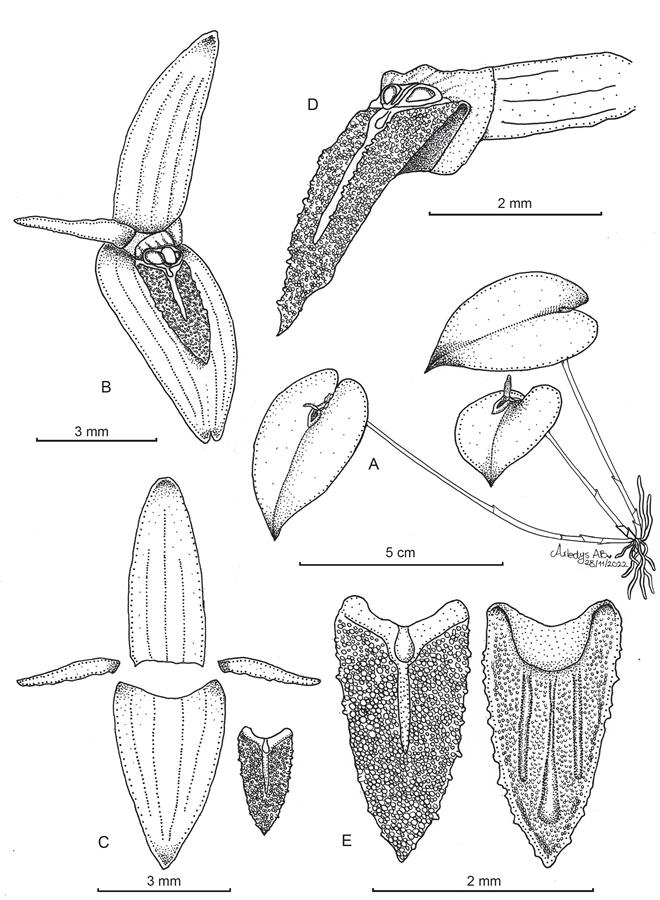
A. Habit.
B. Flower.
C. Dissected perianth.
D. Lip and column, – view.
E. Lip, adaxial and abaxial views. Illustration by A. Albino Bohorquez, based on the plant that served as the holotype.
Figure 1 Pleurothallis franciana Sierra-Ariza.
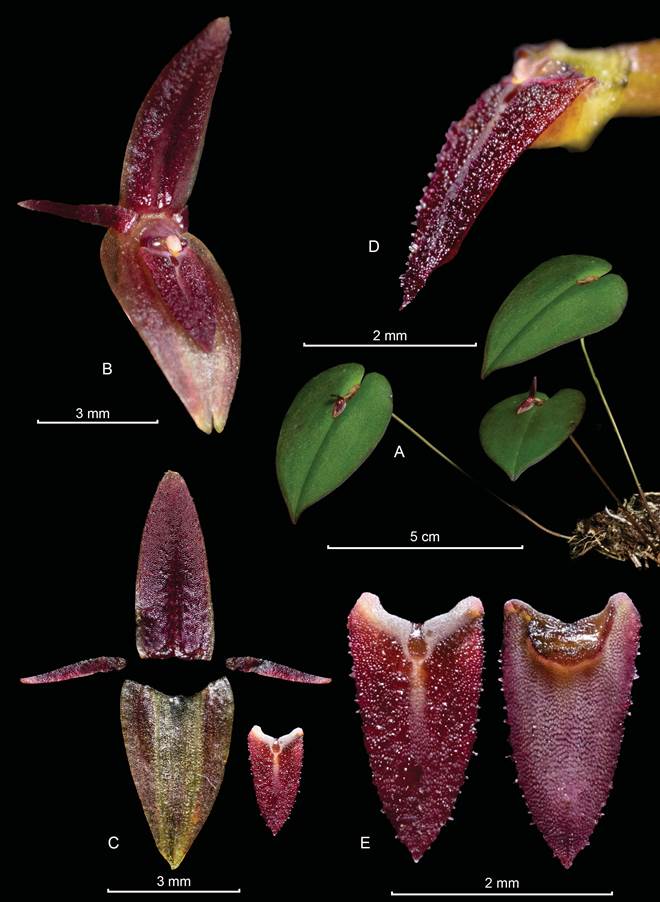
A. Habit.
B. Flower.
C. Dissected perianth.
D. Lip and column, – view.
E. Lip, adaxial and abaxial views.
LCDP by M. A. Sierra-Ariza, based on the plant that served as the holotype.
Figure 2 Pleurothallis franciana Sierra-Ariza.
Distribution and ecology: Pleurothallis franciana was discovered in the Central Cordillera of Colombia, in a fragment of wet premontane forest, in the department of Tolima, at 1976 m of elevation.
This species was found on the edge of a public road near the urban center of Ibagué, in a relict of very degraded forest, surrounded by crops and pastures. It grows as an epiphytic on thin branches and among a sparse covering of bryophytes in dark and humid areas. It has been observed flowering in July.
Discussion. Pleurothallis franciana belongs to the morphological group “P. scabrilinguis” and it has probably the smallest flowers (less than 1 cm long) of the group. The most similar species is P. ariana-dayanae but differs from it by having the dor sal sepal narrowly ovate-lanceolate, rounded, 3.9-4.4 ×1.5-1.9 mm (vs. lanceolate, acute, 6.5-7.8 × 2.3-2.4 mm); the synsepal ovate, acute to bifid, 2.4-2.0 × 4.2-4.5 mm (vs. broadly ovate, acute, 5.8-6.5 × 4.3- 4.5 mm); the lip oblong-lanceolate, acute, 2.2-2.5 × 1.2-1.4 mm, vesiculose (vs. ovate-elliptic, obtuse, 3.2 × 2.0-2.2 mm, verrucose-papillose) and the glenion obovate (vs. slightly bilobed).
This species is also similar to Pleurothallis scabri linguis Lindl., which has larger flowers (1.5 to 2.0 cm long). However, the new species also differs by hav ing the dorsal sepal dorsal narrowly ovate-lanceolate, rounded, 3.9-4.4 ×1.5-1.9 mm (vs. elliptic-ovate, subacute to obtuse, 6-10 × 2.5-7.0 mm); the synse pal ovate, acute to bifid, 2.4-2.7 × 4.2-4.5 mm (vs. broadly ovate, obtuse, shallowly concave, 5-10 × 4-8 mm); the petals linear, acute, 2.3-2.6 × 0.3-0.4 mm (vs. narrowly linear-triangular, acute, 3-7 × 0.50-1.25 mm); the lip oblong-lanceolate, acute, 2.2-2.5 × 1.2-1.4 mm, vesiculose (vs. triangular, oblong, subacute or rounded, 3-7 × 2-4 mm, papillose) and the glenion obovate (vs. obovate, slightly bilobed).
Another similar species is Pleurothallis applanate Luer & Dalström, but the new species differs mainly by having the dorsal sepal narrowly ovate-lanceolate, 3.9-4.4 × 1.5-1.9 mm (vs. narrowly elliptical-ovate, 10 × 3.6 mm); the petals linear, 2.3-2.6 × 0.3-0.4 mm (vs. narrowly linear-triangular, 6.75 × 1.00 mm); the lip oblong-lanceolate, acute, 2.2-2.5 ×1.2-1.4 mm, ve siculose (vs. oblong-ovate, obtuse, 4.5 × 2.2 mm cellular-verrucose) and the glenion obovate (vs. orbicular).
Pleurothallis petroana Sierra-Ariza, sp. nov. (Fig. 3-4).
TYPE: COLOMBIA. Tolima: municipio de Villahermosa, vereda Entrevalles, 3100 m, 25 July 2019, M. A. Sierra-Ariza & A. Albino Bohorquez 194 (holotype: TOLI).
Diagnosis: Pleurothallis petroana is similar to P. sca brilinguis, but the new species differs by an oblong lanceolate dorsal sepal (vs. oblong-ovate), an ovate synsepal (vs. broadly ovate), linear, acuminate petals (vs. narrowly linear-triangular, acute) and a lip ovate lanceolate, verrucose-papillose, slightly pilose (vs. ob long-triangular, subacute or rounded, papillose), with a spathulate glenion (vs. obovate, slightly bilobed).
Plant 15 to 26 cm tall, epiphytic, occasionally ter restrial, caespitose, erect to suberect. Roots slender, 1.3 mm in diameter. Ramicauls yellow-green, 12-24 cm long, with a sheath located at the first basal third and two other sheaths at the base, tubular, broad, papy raceous, brown. Leaf light green, bright, coriaceous, minutely papillate, ovate-lanceolate, acuminate, 7-1 × 4.0-5.5 cm, the base sessile, cordate. Inflorescence a fascicle of successive single-flowers, rarely with two simultaneous flowers, enclosed at the base by a spatha ceous bract ca. 12 mm long; peduncle terete, green, 9-11 mm long; floral bract tubular, papyraceous, acute, 9-11 mm long. Pedicel terete, up to 13 mm long. Ovary light green, papillate, pedicellate, cylin drical, longitudinal sulcate, covered with black dots, 6 mm long. Sepals membranaceous, glandular-papillate, margins irregular. Dorsal sepal dark red, margins pale yellow, oblong-lanceolate, acute, 14-16 × 3.0-4.2 mm, 3-veined. Lateral sepals, connate into an ovate, acute synsepal, dark red with a central yellow stripe and pale yellow margins, concave at the base, 13.5-15.0 × 8.5-9.2 mm, 4-veined. Petals dark red, margins pale yellows, fleshy, linear, acuminate, microscopically verrucose-papillose on the dorsal surface, margins ir regular, minutely denticulate, 7.8-9.0 × 1.2-1.5 mm, 1-veined. Lip yellow-red, fleshy, oblong-lanceolate, acuminate, verrucose-papillose, slightly pilose abaxi ally, margins irregular, denticulate-ciliate, 7.5-8.6 × 3.4-4.2 mm, 3-veined, the disc with a small, spathu late glenion near the base, the base truncate forming two pronounced lobes, subacute. Column light red, short, broad, semiterete, margins irregular, 1.5 × 1.2 mm, with a short, thick; stigma apical, bilobed. Anther cap light red, apical, obovate, minutely papillose, 0.6 × 0.5 mm Pollinia 2, yellow, obovoid. Capsule not seen.
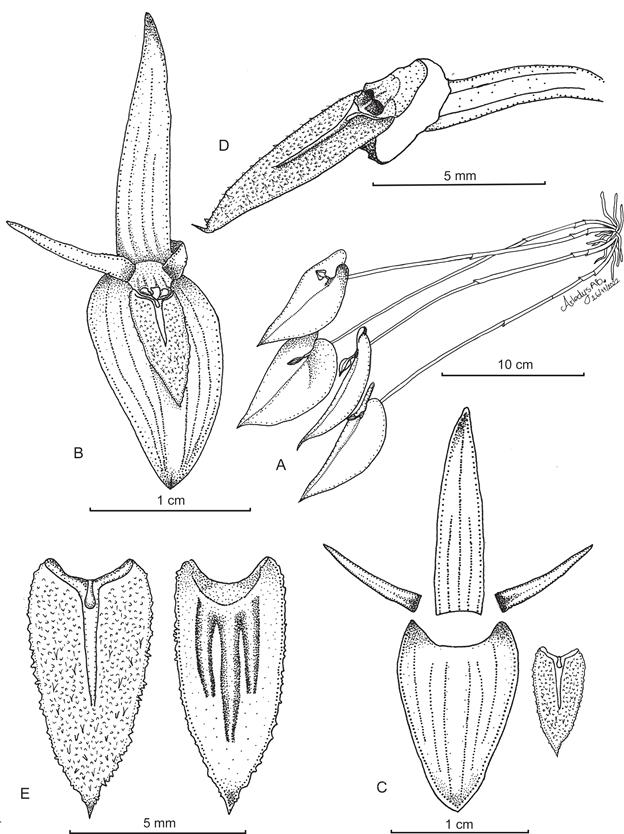
A. Habit.
B. Flower.
C. Dissected perianth.
D. Lip and column, – view.
E. Lip, adaxial and abaxial views.
Illustration by A. Albino Bohorquez, based on the plant that served as the holotype.
Figure 3 Pleurothallis petroana Sierra-Ariza.
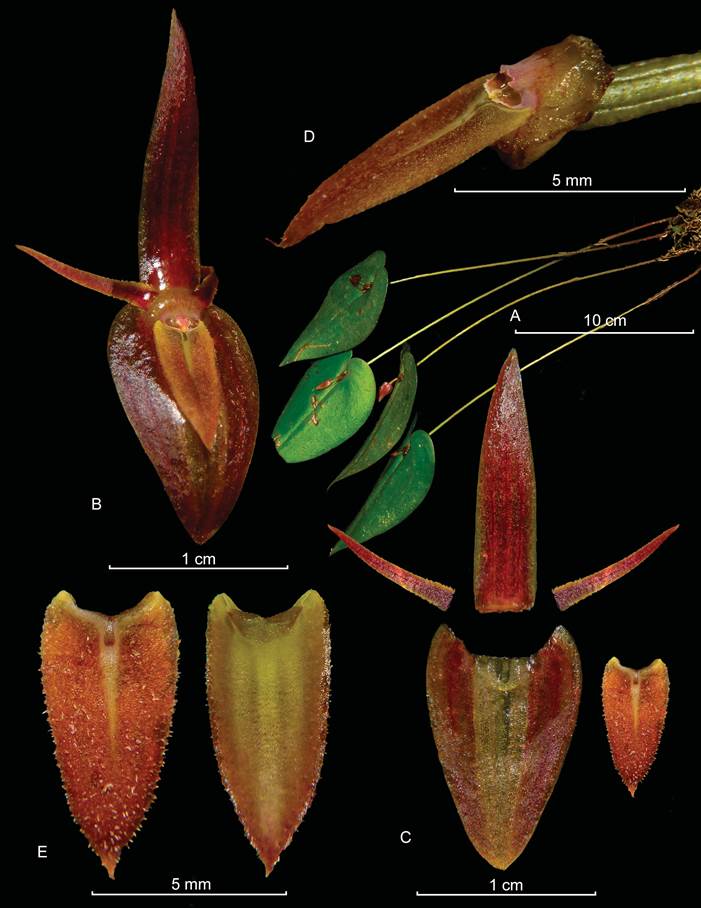
A. Habit.
B. Flower.
C. Dissected perianth.
D. Lip and column, – view.
E. Lip, adaxial and abaxial views.
LCDP by M. A. Sierra-Ariza, based on type.
Figure 4 Pleurothallis petroana Sierra-Ariza.

A. Pleurothallis franciana.
B. Pleurothallis petroana. by M. A. Sierra-Ariza.
Figure 5 Photographs of the new species in situ.
Eponymy: In honor of Gustavo Francisco Petro Urrego, President of the Republic of Colombia (2022-2026), in commemoration of his political career; winner of the Letelier-Moffitt Human Rights Award (2007); tire less supporter of social causes and interest in caring for the environment and mitigating climate change.
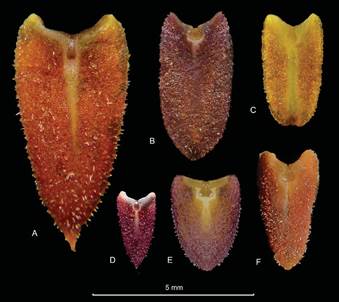
A. P. petroana.
B. P. aff paquishae.
C. P. aff. applanata.
D. P. franciana.
E. P. ariana-dayanae.
F. P. scabrilinguis.
Photographs by M. M. Jiménez (B, C, E, F) and M. A. Sierra-Ariza (A, D).
Prepared by M. A. Sierra-Ariza.
Figure 6 Adaxial view of the lip in morphologically similar species of Pleurothallis.
Distribution and ecology: Pleurothallis petroana was found in a fragment of montane rainforest in the munici pality of Villahermosa, Tolima, between 3000 and 3200 m of elevation. It inhabits ecosystems that have been heavily disturbed by the expansion of the agricultural frontier. It grows as epiphytic in small forest fragments, on tree branches among bryophytes and constant shade. It is also a terrestrial on roadside ravines with high solar radiation. It flowered in June and July (Fig. 5).
Discussion. Pleurothallis petroana belongs to the “P. scabrilinguis” group showing big flowers, up to 3 cm long. It is similar to P. scabrilinguis, but it shows larg er flowers (vs. 1.5 to 2.0 cm long). Also, Pleurothallis petroana differs from it by the dorsal sepal oblong-lan ceolate, acute, 12-15 × 3.2-4.0 mm (vs. elliptic-ovate, subacute to obtuse, 6-10 × 2.5-7.0 mm); the ovate, rounded, synsepal 12.3-14.0 × 8.3-9.0 mm (vs. broad ly ovate, obtuse, shallowly concave, 5-10 × 4-8 mm); the petals linear, acuminate, 7.2-8.3 × 1.2-1.4 mm (vs. narrowly linear-triangular, acute, 3-7 × 0.5.0-1.25 mm); the lip oblong-lanceolate, acuminate, 7.5-8.2 × 3.0-3.4 mm, verrucose-papillose, slightly pilose (vs. triangular, oblong, subacute or rounded, 3-7 × 2-4 mm, papillose) and the spathulate glenion (vs. obovate, slightly bilobed).
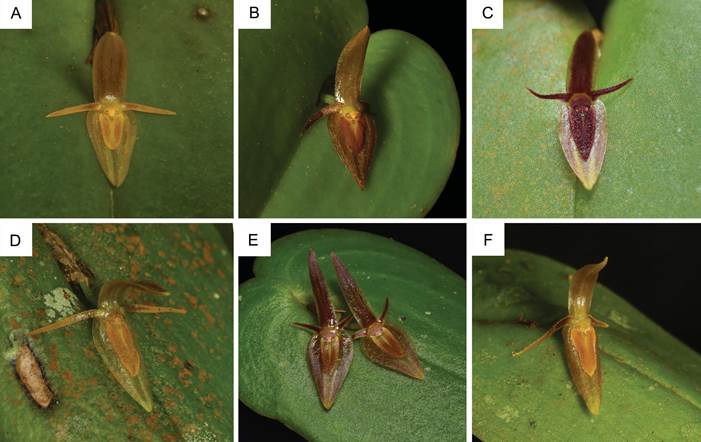
A. P. aff. applanata.
B. P. ariana-dayanae.
C. P. franciana.
D. P. aff. paquishae.
E. P. petroana.
F. P. scabrilinguis.
Photographs by M. M. Jiménez (A, D, F), L. Vélez-Abarca (B), and M. A. Sierra-Ariza (C, E). Prepared by M. A. Sierra-Ariza.
Figure 7 Flower morphology of similar species of Pleurothallis.
This species is also similar to Pleurothallis paqui shae Luer, but it differs in the oblong-lanceolate dorsal sepal, 12-15 × 3.2-4.0 mm (vs. narrowly elliptic, 9.5- 3.3 mm); the synsepal elliptical, acute to acuminate, 13 × 6 mm (vs. ovate acute, 9.4 × 5.6 mm); the petals linear, acuminate, 7.2-8.3 × 1.2-1.4 mm (vs. narrowly linear-oblong, acute, 9 × 0.8 mm); the lip oblong-lan ceolate, acuminate, 7.5-8.2 × 3.0-3.4 mm, verrucose papillose, slightly pilose (vs. oblong, acute, 6.2 × 2.7 mm, verrucose-spiculated) and the glenion spathulate (vs. oblong, slightly bilobed).
Another similar species is P. applanata, but P. petroana differs by the dorsal sepal oblong-lanceolate, acute, 12-15 × 3.2-4.0 mm (vs. narrowly elliptical-ovate, 10.0 × 3.6 mm); the petals linear, acuminate, 7.2-8.3 × 1.2-1.4 mm (vs. narrowly linear-triangular, 6.75 × 1.00 mm); the lip oblong-lanceolate, acuminate, 7.5-8.2 × 3.0-3.4 mm, verrucose-papillose, slightly pilose (vs. oblong-ovate, obtuse, 4.5 × 2.2 mm cellular verrucose) and the spathulate glenion (vs. orbicular) (Fig. 6-7).












 uBio
uBio 

